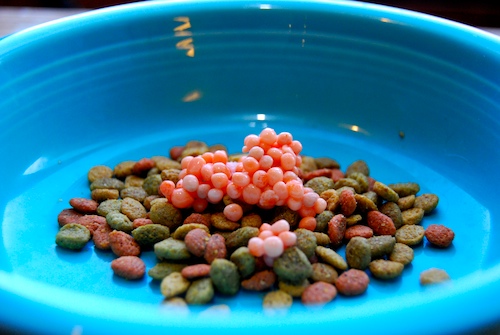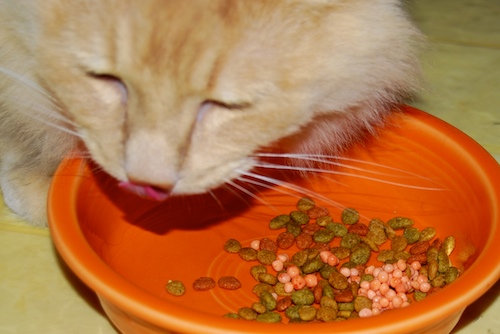
Beautiful eggs fresh from Kenai Sock-eye (red) salmon.
| UAF · UAF IAB · UAF Library · UAF Directory | Takebayashi Lab Page · email: ntakebayashi@alaska.edu |
Wash the eggs briefly under running water.

Beautiful eggs fresh from Kenai Sock-eye (red) salmon.
The first task is to separate the eggs from the egg sacks. Here, I'm using warm-water method. The temperature of water is critical. The membrane around the sacks shrinks with heat. However, we want to minimize the effect of heat on eggs. If the temperature of the water is too hot, the texture of eggs become undesirable (outside of the eggs become too hard). If it is too low, separation takes long time. The correct temperature makes separation of eggs real easy.
Add 1 table spoon (tbs) of table salt to 4 quarts of water in a pan
and heat it up. The temperature should be around 70C (158F). The
proteins in eggs start to denature around 70C (158F). But the
temperature goes down when you put the eggs in the hot water. I would
make sure that you have enough hot water relative to the eggs, so you
can keep above 60C for a couple minutes. If you
don't have thermometer, use your finger tip as the gauge. At this
temp, you will feel it to be very hot, but you can still leave your
fingers there for a minute or so.

Tips: Addition of
salt is optional. Without salt or with less salt, water can penetrate
to inside of eggs, and it creates "crispier" texture. But eggs are
more likely to explode. In most other recipes, they seem to use a lot
more salt than this recipe, but I prefer crispier texture, so I'm
using less salt than other recipes. If you add too much salt, water
will move out of eggs, and they will have shrivelled look.
Note that it is important to use hot enough water which kills
parasitic nematodes,
Anisakis.
This parasite quickly dies at 70C (158F). But it also dies at a lower
temperature, 60C (140F), after 1 munute. Just to be safe, I keep at
least 60C for 3-4 minutes. Alternatively, freezing them at -20C (-4F)
for 24 hours would kill them, but home freezers don't go this low, so
I'm not sure how effective it is with home freezers.
Remove the pan from the stove at this temp, and add the egg
sacks. Stir it once or twice, and wait for 5-10 minutes.

The temperature goes down slightly after I put cold eggs. That's why
I started from 60C (140F). From looking at the final result, I would
have gotten nicer looking ikura if I had started from 2-3 degrees
lower temperature (138F).
After 5 minutes or so, hopefully the hot water has cooled down a
little bit, so you can start to separate eggs. If it is too hot, you
can add a little bit of cold water. Use your fingers to separate
eggs. It comes out pretty easily, and eggs don't break down.

When you are done, you'll be left with the membrane of egg sacks.

Ditch this membrane.
Drain the hot water into the strainer. I briefly rinse them with
lukewarm water (to wash off small sand grains).

Return the eggs to the pan.

Add warm water from the tap (it shouldn't be too hot), and you'll
notice that white fuzzy stuff (left over egg sack membrane) start to
float. Eggs sink to the bottom, so you can pour out the hot water to
get rid of the fuzzy stuff.

Repeat the rinse twice (or more if you want to). Then drain with a
strainer.

Notice that the eggs became a little opaque, but don't worry. The
translucent, sparkling color should come back later.
Leave the eggs in the strainer and wait for 1 hour. You can leave the
strainer in refrigerator if you prefer. Also you might want to put
saran wrap on the top to prevent drying. I put the strainer in the
pan, and covered them with a rid.

Now, put the eggs into some container, add one of the following sauces, and refrigerate for at least 3-4 hours. There are two kinds of sauces good for this recipe. I like Shouyu-zuke, which is great for ikura-don (ikura on rice). Ikura used for sushi is usually Shio-zuke (salt based), which ends up in brighter color than Shouyu-zuke.
With 2 cups of eggs (from 1-2 fish), following amount works:
A. Shouyu-zuke (soy sauce based)
| 1/4 cup (cp) | soy sauce | 1/8 cp | mirin | 1/8 cp | sake (I usually substitute it with dry white wine.) | 1 table spoon (tbs) | water |
B. Shio-zuke (salt based)
| 1 & 1/2 tea spoon (tsp) | salt | 2 tsp | mirin | 1 & 1/2 tbs | sake (or dry white wine) | 3 tbs | soup* (or water)
|
Pour them on top of rice (with a little sauce from the container,
too), and enjoy.

Ikura should last at least 1-2 weeks in the refrigerator. You should be able to freeze them for a longer storage.
Eggs not soaked in the sauce are great on kibbles, too:

Buddy loves Ikura-don for kitties:
